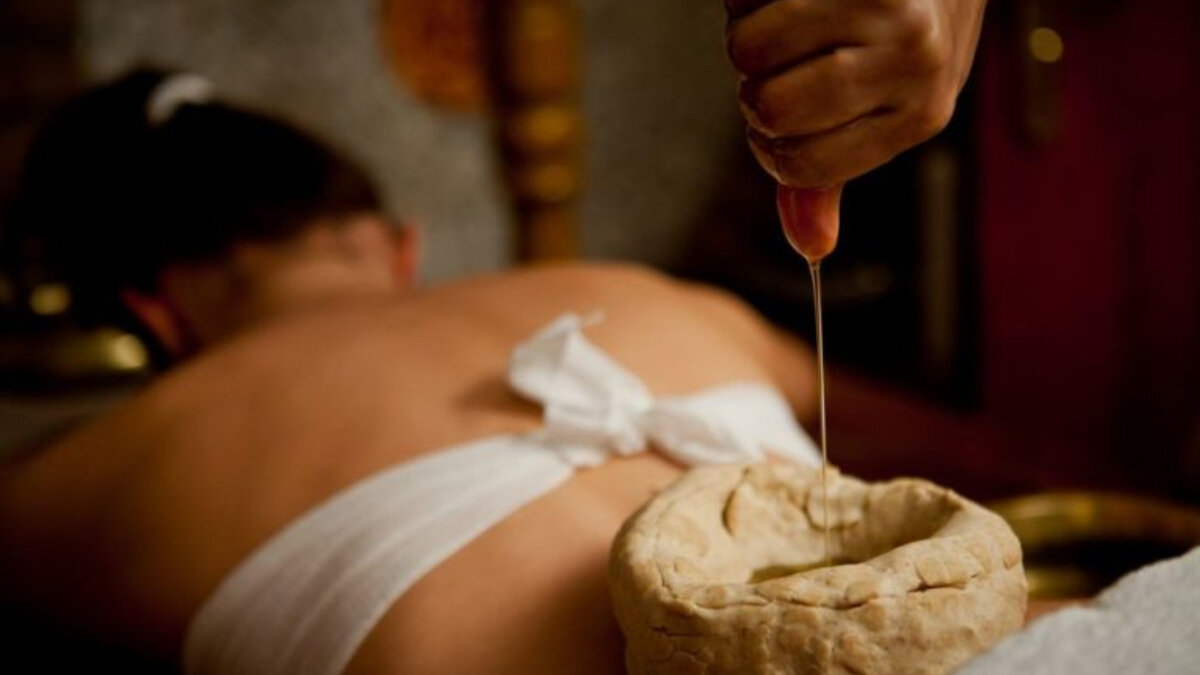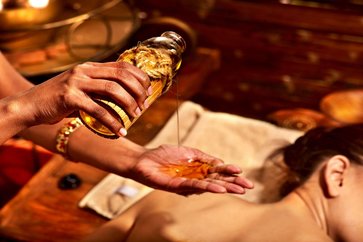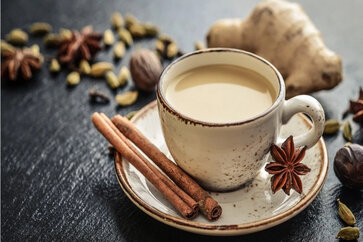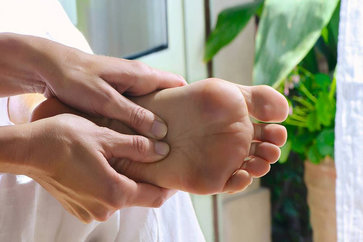Kativasti: The Ancient Ayurvedic Therapy for Back Pain Relief
In Ayurveda, the term “Kativasti” carries significant meaning. “Kati” in Sanskrit refers to the waist region in our body, while “Vasti” translates to “that which can hold” or “that which can retain.” Kativasti is a specialized form of local snigdha (moist) Sweda (perspiration) where warm oil is applied to the kati Pradesh, which is the waist region, for a specific period of time. 
The patient lies in a prone position, and the Kati Pradesh is encircled with a thick paste made from black gram (known as “maasha” in Sanskrit) to retain the oil effectively. One of the remarkable aspects of Kativasti is its targeted application, directly addressing the site of the lesion.
Furthermore, this therapeutic procedure is not limited to the waist region alone; it can be performed in other areas like the greens (cervical region), janu (knee), uras (chest), etc., with appropriate names given to each variation. Kativasti is categorized as a Samana procedure, indicating that it functions as a type of palliative intervention.
In essence, Kativasti is an ancient Ayurvedic therapy that utilizes warm oil to address specific ailments and promote overall well-being. Its localized approach and careful use of herbal ingredients make it a unique and effective healing practice within the realm of Ayurveda.
The Origins of Kativasti
Kativasti has a rich history dating back thousands of years in Ayurvedic scriptures. It is believed to have been first mentioned in the ancient text called “Sushruta Samhita,” attributed to the sage Sushruta.
He is often referred to as the “Father of Surgery” in Ayurveda. This historical reference highlights the significance of Kativasti as a valuable therapeutic intervention even during ancient times.
Understanding the Concept of Doshas in Ayurveda
Before diving into the specifics of Kativasti, it is essential to comprehend the fundamental concept of doshas in Ayurveda. According to Ayurvedic philosophy, the human body comprises three primary doshas: Vata, Pitta, and Kapha.
These doshas represent various elemental forces and are responsible for governing different physiological and psychological functions. An imbalance in these doshas is believed to lead to various health issues, including back pain.
How Kativasti Works?
Kativasti works on the principle of localized healing, focusing primarily on the lower back region. The process involves the following steps:
1. Preparation
Before commencing the Kativasti therapy, a critical preparatory stage takes place. The individual undergoes a comprehensive examination by an experienced Ayurvedic practitioner.
This examination aims to determine the individual’s unique dosha constitution and identify any underlying health imbalances.
This thorough evaluation ensures that the Kativasti treatment is personalized and tailored to the specific needs of the individual, maximizing the therapeutic benefits and promoting overall well-being.
2. Preparation of Dough
During the Kativasti therapy, a crucial step involves crafting a ring-shaped structure on the lower back. This specialized structure is made using a unique dough prepared from either black gram or wheat flour.
With utmost care and precision, the dough is meticulously placed to cover the affected area, forming a boundary that will serve as the container for the warm herbal oil.
This well-liked structure is essential for retaining the oil and allowing it to work its therapeutic magic on the targeted region, providing relief and nourishment to the lower back.
3. Medicated Oil
After carefully forming the dough boundary on the lower back, the next step in Kativasti involves filling it with warm, medicated herbal oil.
The selection of this oil is based on the individual’s unique dosha constitution and specific health conditions. Each person’s dosha imbalance and health requirements vary, and the choice of medicated oil is precisely tailored to address their specific needs.
This therapeutic blend of warm herbal oil will be the conduit for delivering healing properties to the affected area during the Kativasti procedure, promoting relief and rejuvenation.
4. Retaining the Oil
Once the medicated oil is carefully poured into the dough boundary, it is retained within this confined space for a duration typically ranging from 30 to 45 minutes.
During this period, the therapeutic properties of the oil work their magic, penetrating deep into the tissues, muscles, and nerves of the lower back.
This uninterrupted retention allows the warm herbal oil to effectively seep into the affected areas, providing profound nourishment and healing.
The therapeutic synergy between the oil and the targeted region creates a harmonious balance, offering relief and revitalization to the lower back.
5. Massage and Post-treatment
Following the completion of the Kativasti therapy, the next step involves a soothing and gentle massage administered to the treated area. This post-treatment massage further enhances relaxation and rejuvenation, complementing the therapeutic effects of Kativasti.
To optimize the results of the therapy, the individual may receive valuable advice from the Ayurvedic practitioner. This advice may include the recommendation to take ample rest and avoid certain activities that could potentially hinder the healing process.
Embracing this guidance ensures that the benefits of Kativasti are fully realized, allowing the body to fully absorb the healing properties of the warm herbal oil and promoting overall well-being.
How to make Kati Vasti oil
To make Kati Vasti oil, you will need to infuse a carrier oil with specific medicinal herbs. Kati Vasti is an Ayurvedic therapy used to alleviate lower back pain and related issues.
The oil used in this therapy is usually warm and medicated to provide therapeutic benefits. Here’s a simple recipe to make Kati Vasti oil:
Ingredients:
1. Sesame oil or Coconut oil – 1 cup (Choose cold-pressed and organic if possible)
2. Medicinal herbs (choose from the following):
3. Dashamoola (a combination of ten roots)
4. Nirgundi (Vitex negundo) leaves
5. Shallaki (Boswellia serrata) resin
6. Devadaru (Cedrus deodara) bark
7. Rasna (Pluchea lanceolata) leaves
8.Erandamoola (Ricinus communis) roots
Instructions:
1. Take a clean, dry glass jar with a tight-fitting lid.
2. If you are using Dashamoola or Erandamoola, you can use the powdered form. For other herbs, you can use them in the dried whole form or crush them slightly to release their essence.
3. Mix the chosen medicinal herbs together and add them to the glass jar.
4. Heat the sesame oil or coconut oil in a pan on low heat. Warm it gently; do not overheat or boil the oil.
5. Pour the warm oil into the glass jar containing the medicinal herbs. Fill it to the brim.
6. Close the jar with the lid tightly.
7. Place the jar in a warm and sunny spot, like a windowsill, for about 3-4 weeks. This allows the herbs to infuse their properties into the oil.
8. Shake the jar gently every day to ensure the herbs are evenly distributed and the oil gets infused properly.
9. After 3-4 weeks, strain the oil through a clean muslin cloth or a fine strainer into another clean glass jar or bottle. Squeeze out as much oil as possible from the herbs.
10. Your Kati Vasti oil is now ready to use.
How to use Kati Vasti oil?
Before using the oil, warm it slightly by placing the bottle in a bowl of hot water. Ensure it’s comfortably warm, not too hot to avoid burns. During a Kati Vasti therapy session, a qualified Ayurvedic practitioner will apply this warm oil on the lower back area, creating a small reservoir using a dough ring, and let it stay there for a certain duration as per the treatment plan.
Note: Remember, Ayurvedic treatments should be done under the guidance of a qualified practitioner, as they can recommend the most suitable herbs and oil for your specific condition and ensure safe and effective use.
Kati Basti Treatment Benefits
Kativasti offers a wide range of benefits for both physical and mental well-being. Some of the key advantages include:
1. Relief from Back Pain
Kativasti has gained widespread recognition for its remarkable ability to alleviate chronic lower back pain, sciatica, and lumbar spondylosis.
The application of warm herbal oil during the therapy works wonders in soothing inflammation and reducing discomfort, offering much-needed relief to those suffering from these conditions.
2. Spinal Health
Kativasti plays a crucial role in promoting spinal health by nourishing the spine and the surrounding muscles. This therapeutic procedure improves spinal flexibility and strength, effectively reducing the risk of developing spinal disorders.
By focusing on the well-being of the spine, Kativasti contributes to overall physical wellness and better quality of life.
3. Improved Posture
One of the significant benefits of Kativasti is its ability to address and rectify postural imbalances. Through this therapeutic intervention, Kativasti enhances body alignment, which is essential for maintaining a healthy musculoskeletal system.
By promoting proper posture, this therapy aids in preventing potential musculoskeletal issues and contributes to overall physical well-being.
4. Enhanced Blood Circulation
Kativasti’s application of warm oil serves as a powerful stimulant for blood flow in the lower back region. This increased circulation leads to a better nutrient supply to the area and aids in the effective elimination of toxins.
The therapy’s ability to promote enhanced blood circulation contributes significantly to the overall rejuvenation and healing process, making Kativasti a valuable therapeutic intervention for various back-related issues.
5. Stress Reduction
Beyond its physical benefits, Kativasti also holds the power to reduce stress and anxiety through its deeply relaxing nature. As the therapy unfolds, it calms the mind, providing a sense of tranquility and inner peace.
By easing the burden of stress, Kativasti fosters an overall sense of well-being, promoting not only physical healing but also emotional and mental rejuvenation.
Embracing this ancient Ayurvedic practice can be a transformative step towards achieving a balanced and harmonious state of being.
Ayurvedic Treatments for Back Pain
While Kativasti is one of the most effective Ayurvedic treatments for back pain, several other therapies exist within the realm of Ayurveda to address this common health issue. Let’s explore some of these treatments:
1. Abhyanga: This full-body oil massage not only relaxes the muscles but also promotes overall circulation and detoxification, benefiting the back muscles and nerves.
2. Kashaya Vasti: In this therapy, a warm herbal decoction is retained within a dough boundary on the lower back to alleviate back pain and inflammation.
3. Pizhichil: Also known as “Thailadhara,” Pizhichil involves pouring warm herbal oil over the body while simultaneously massaging it. It is effective for various musculoskeletal conditions.
4. Kizhi: In this therapy, herbal poultices are applied to the affected areas, providing relief from pain and inflammation.
5. Shashtika Shali Pinda Sweda: This treatment involves a massage using a bolus filled with cooked rice and milk, offering relief from muscle and joint pain.
Ayurvedic Approach to Back Pain Management
Ayurveda, as an ancient holistic healing system, takes a comprehensive approach to back pain management. Instead of merely focusing on symptomatic relief, Ayurvedic treatments aim to identify and address the root cause of the issue. Here are some principles that underpin Ayurvedic back pain management:
1. Dosha Analysis: The Ayurvedic practitioner assesses the individual’s dosha constitution and identifies any imbalances that might be contributing to the back pain.
2. Dietary Recommendations: Based on the dosha analysis, personalized dietary guidelines are provided to balance the doshas and support the body’s natural healing mechanisms.
3. Lifestyle Modifications: Certain lifestyle habits might aggravate back pain. Ayurveda recommends lifestyle modifications to alleviate pain and promote a healthy spine.
4. Yoga and Exercise: Specific yoga asanas and exercises are prescribed to strengthen the back muscles, improve flexibility, and correct postural issues.
5. Meditation and Stress Management: Stress is a significant contributor to back pain. Meditation and stress management techniques are integrated into the treatment plan.
Frequently Asked Questions (FAQs) on Kativasti
Q: What is the ideal frequency of Kativasti sessions?
A: The frequency of Kativasti sessions varies depending on the individual’s condition. Typically, a series of 7 to 14 sessions, scheduled on alternate days or as advised by the Ayurvedic practitioner, is recommended for optimal results.
Q: Is Kativasti safe for everyone?
A: Kativasti is generally safe for most individuals. However, pregnant women, those with severe medical conditions, or acute injuries in the lower back should avoid this therapy. It is essential to consult a qualified Ayurvedic practitioner before undergoing the treatment.
Q: Can Kativasti be combined with other Ayurvedic treatments?
A: Yes, Kativasti can be combined with other Ayurvedic therapies like Abhyanga, Pizhichil, and Kizhi, based on individual needs. The combination of treatments can enhance the overall healing process.
Q: How long does it take to experience the benefits of Kativasti?
A: Some individuals may experience immediate relief after the first session, while others may require a few sessions to notice significant improvements. Consistency and adherence to the treatment plan are key to achieving lasting benefits.
Q: Are there any side effects of Kativasti?
A: When performed by a skilled Ayurvedic practitioner, Kativasti is generally safe and well-tolerated. However, in rare cases, individuals with sensitive skin may experience mild irritation or redness, which usually subsides quickly.
Q: Can Kativasti be self-administered at home?
A: Kativasti involves specialized techniques and knowledge. It should only be performed by a trained Ayurvedic therapist to ensure safety and effectiveness.
Conclusion
Kativasti is a time-tested Ayurvedic therapy that offers numerous benefits for back pain relief and overall well-being. Its holistic approach, coupled with the wisdom of Ayurveda, makes it a valuable addition to modern healthcare practices.
If you suffer from back pain or seek a natural way to improve your spinal health, consider exploring the wonders of Kativasti under the guidance of a qualified Ayurvedic practitioner.
Remember, Ayurveda emphasizes individualized treatment, so it’s essential to consult an experienced practitioner who can tailor the therapy to suit your unique needs. Embrace the ancient healing power of Kativasti and experience the transformative impact it can have on your life.
References:
- EFFICACY OF KATI VASTI IN THE MANAGEMENT FOR BACK PAIN- CASE STUDY(1)
- ROLE OF KATIVASTI IN THE MANAGEMENT OF SANDHIGATA VATA (LUMBAR SPONDYLOSIS): A PILOT STUDY(2)
- Effectiveness of Kativasti and exercise in chronic low back pain: a randomize control study(3)
- A CLINICAL STUDY ON KATIVASTI AND YOGASANA IN THE MANAGEMENT OF
KATISHOOL WITH SPECIAL REFERENCE TO LOW BACK ACHE(4)

























